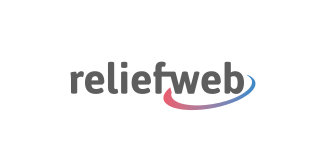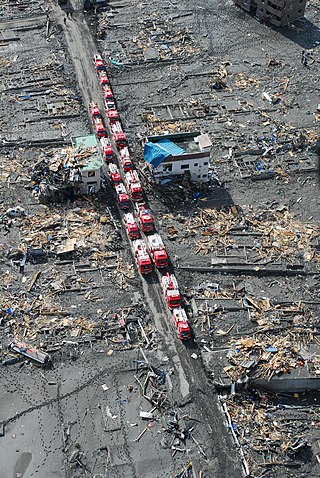Related Research Articles

The Mata Amritanandamayi Math (MAM) is an international charitable organization aimed at the spiritual and material upliftment of humankind. It was founded by Indian spiritual leader and humanitarian Mata Amritanandamayi in 1981, with its headquarters in Paryakadavu, Alappad Panchayat, Kollam district, Kerala. Along with its sister organization, the Mata Amritanandamayi Mission Trust, MAM conducts charitable work including disaster relief, healthcare for the poor, environmental programs, fighting hunger and scholarships for impoverished students, amongst others. It also runs the seven-campus university known as Amrita Vishwa Vidyapeetham, 90 chain of English medium CBSE schools known as Amrita Vidyalayam, and classes in yoga, meditation and Sanskrit.

The United Nations Office for the Coordination of Humanitarian Affairs (OCHA) is a United Nations (UN) body established in December 1991 by the General Assembly to strengthen the international response to complex emergencies and natural disasters. It is the successor to the Office of the United Nations Disaster Relief Coordinator (UNDRO).
Pacific Disaster Center (PDC) is an applied science, information and technology center, working to reduce disaster risks and impacts on life, property, and the economies worldwide.

ReliefWeb (RW) is a humanitarian information portal founded in 1996. As of July 2023, it hosts more than one million humanitarian situation reports, press releases, evaluations, guidelines, assessments, maps and infographics. The portal is an independent source of information, designed specifically to assist the international humanitarian community in effective delivery of emergency assistance or relief. It provides information as humanitarian crises unfold, while emphasizing the coverage of "forgotten emergencies" at the same time.

Humanity First is an international charity that provides disaster relief and long term development assistance to vulnerable communities in 52 countries across 6 continents. The organisation is run by volunteers with diverse skillsets across the world and has access to thousands of extra volunteers worldwide. Volunteer staff in all areas often pay their own expenses to support the international projects.
Americares is a global non-profit organization focused on health and development that responds to individuals affected by poverty, disaster, or crisis. The organization addresses poverty, disasters, or crises with medicine, medical supplies and health programs.
ShelterBox is an international disaster relief charity established in 2000 in Helston, Cornwall, UK, that provides emergency shelter and other aid items to families around the world who have lost their homes to disaster or conflict.
JEN, formerly named Japan Emergency NGOs, was established in January 1994 as the first federation of Japanese NGOs.
IsraAID is an Israel-based non-governmental organization that responds to emergencies all over the world with targeted humanitarian help. This includes disaster relief, from search and rescue to rebuilding communities and schools, to providing aid packages, medical assistance, and post-psychotrauma care. IsraAID has also been involved in an increasing number of international development projects with focuses on agriculture, medicine, and mental health.

The response to the 2010 Haiti earthquake included national governments, charitable and for-profit organizations from around the world which began coordinating humanitarian aid designed to help the Haitian people. Some countries arranged to send relief and rescue workers and humanitarian supplies directly to the earthquake damage zones, while others sought to organize national fund raising to provide monetary support for the nonprofit groups working directly in Haiti. OCHA coordinates and tracks this on a daily basis. The information is disseminated through the UN news and information portal, ReliefWeb. As of September 5, 2013, ReliefWeb have reported a total relief funding of $3.5 billion given.
A crisis camp is a BarCamp gathering of IT professionals, software developers, and computer programmers to aid in the relief efforts of a major crisis such as those caused by earthquakes, floods, or hurricanes. Projects that crisis camps often work on include setting up social networks for people to locate missing friends and relatives, creating maps of affected areas, and creating inventories of needed items such as food and clothing.

Google Person Finder is an open source web application that provides a registry and message board for survivors, family, and loved ones affected by a natural disaster to post and search for information about each other's status and whereabouts. It was created by volunteer Google engineers in response to the 2010 Haiti earthquake.
Download to Donate is a program by Music for Relief, a non-profit organization established by Linkin Park in 2005 to aid victims of natural disasters in their recovery efforts. So far, the program has released three compilations: two to support the 2010 earthquake in Haiti and one for the 2011 Tōhoku earthquake and tsunami. Several artists contribute songs to the compilations, and people are encouraged to either download the songs, in which the proceeds will go to relief efforts for the disasters; or to simply donate any amount money for the cause.
Google Crisis Response is a team within Google.org that "seeks to make critical information more accessible around natural disasters and humanitarian crises". The team has responded in the past to the 2010 Haiti earthquake, 2010 Pakistan floods, 2010–11 Queensland floods, February 2011 Christchurch earthquake, and the 2011 Tōhoku earthquake and tsunami among other events, using Google resources and tools such as Google Maps, Google Earth, Google Person Finder, and Google Fusion Tables.

The aftermath of the 2011 Tōhoku earthquake and tsunami included both a humanitarian crisis and massive economic impacts. The tsunami created over 300,000 refugees in the Tōhoku region of Japan, and resulted in shortages of food, water, shelter, medicine and fuel for survivors. 15,900 deaths have been confirmed. In response to the crisis, the Japanese government mobilized the Self-Defence Forces, while many countries sent search and rescue teams to help search for survivors. Aid organizations both in Japan and worldwide also responded, with the Japanese Red Cross reporting $1 billion in donations. The economic impact included both immediate problems, with industrial production suspended in many factories, and the longer term issue of the cost of rebuilding which has been estimated at ¥10 trillion.

Crisis mapping is the real-time gathering, display and analysis of data during a crisis, usually a natural disaster or social/political conflict. Crisis mapping projects usually allows large numbers of people, including the public and crisis responders, to contribute information either remotely or from the site of the crisis. One benefit of the crisis mapping method over others is that it can increase situational awareness, since the public can report information and improve data management.

The Digital Humanitarian Network is a consortium allowing Volunteer and Technical Communities (V&TCs) to interface with humanitarian organizations that seek their services.
Sahana Software Foundation is a Los Angeles, California-based non-profit organization founded to promote free and open-source software (FOSS) for disaster and emergency management. The foundation's mission statement is to "save lives by providing information management solutions that enable organizations and communities to better prepare for and respond to disasters." The foundation's Sahana family of software products includes Eden, designed for humanitarian needs management; Vesuvius, focused on the disaster preparedness needs of the medical community; and legacy earlier versions of Sahana software including Krakatoa, descended from the original Sahana code base developed following the 2004 Indian Ocean tsunami. The word "Sahana" means "relief" in Sinhalese, one of two national languages of Sri Lanka.
Mercy Relief is a Non-Governmental humanitarian organization based in Singapore. The organization was officially launched in 2003 by the then-Deputy Prime Minister of Singapore, Mr Lee Hsien Loong. Apart from responding to immediate disasters in the Asian region, its longer-term developmental projects also focus on water & sanitation, shelter, sustainable livelihoods, healthcare and education.
All Partners Access Network (APAN), formerly called Asia-Pacific Area Network, is a United States Department of Defense (USDOD) social networking website used for information sharing and collaboration. APAN is the premier collaboration enterprise for the USDOD. The APAN network of communities fosters multinational interaction and multilateral cooperation by allowing users to post multimedia and other content in blogs, wikis, forums, document libraries and media galleries. APAN is used for humanitarian assistance and disaster relief, exercise planning, conferences and work groups. APAN provides non-governmental organizations (NGOs) and U.S. partner nations who do not have access to traditional, closed USDOD networks with an unclassified tool to communicate.
References
- ↑ Robin Low (18 October 2016). Good Intentions Are Not Enough: Why We Fail at Helping Others. World Scientific. p. 111. ISBN 978-981-320-059-3.
- ↑ "Disaster Relief 2.0: The Future of Humanitarian Information Sharing", UN OCHA
- ↑ Shahla F. Ali (13 June 2016). Governing Disasters: Engaging Local Populations in Humanitarian Relief. Cambridge University Press. p. 232. ISBN 978-1-316-59845-0.